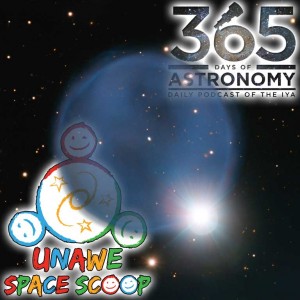Podcaster: Avivah Yamani
Title: Space Scoop: Diamonds in the Sky
Organization: Astrosphere New Media
Link : astrosphere.org ; http://unawe.org/kids/unawe1415/
Description: Space scoop, news for children.
Bio: Avivah Yamani is a Project manager of 365 Days Of Astronomy
Today’s sponsor: This episode of “365 Days of Astronomy” is sponsored by — no one. We still need sponsors for many days in 2014, so please consider sponsoring a day or two. Just click on the “Donate” button on the lower left side of this webpage, or contact us at signup@365daysofastronomy.org.
Transcript:
This is 365 Days of Astronomy. Today we bring you a new episode in our Space Scoop Series. This show is produced in collaboration with Universe Awareness, a program that strives to inspire every child with our wonderful cosmos.
Today’s story: Diamonds in the Sky

Using the Very Large Telescope in Chile, astronomers have captured this priceless photograph of what looks remarkably like a diamond engagement ring! The blue bubble is a planetary nebula known as Abell 33, which was created when an aging star blew away its outer layers of gas into a gigantic cosmic bubble.
Using the Very Large Telescope in Chile, astronomers have captured this priceless photograph of what looks remarkably like a diamond engagement ring!
The blue bubble is a planetary nebula known as Abell 33. Planetary nebulae are created when an aging star blows away its outer layers of gas in a gigantic cosmic bubble.
Unusually, Abell 33 appears to be a perfect circle in the sky. Being perfectly round is rare for these objects because usually something disturbs them and causes the nebulas to morph into irregular shapes.
Creating the illusion of the cosmic diamond is a bright star along the rim of the nebula. In reality, the star lies much closer to Earth than the nebula. The star is about 700 light years away, that is halfway between Earth and the nebula. However, the chance alignment in this photograph creates a marvellous illusion.
At the centre of the ring, you can see the remains of the star that created this planetary nebula, now a white dwarf. Visible as a tiny white pearl, this star is still bright — brighter than our own Sun — and shines enough light to make the bubble of gas glow.
The interesting thing is that the white dwarf star will eventually form a core of crystallized carbon, much like diamond!
Cool Fact: Eventually, over a very long time, each white dwarf will cool to temperatures so low that it will no longer shine at all, and it will become what we call a “black dwarf”.
365 Days of Astronomy is a community podcast made possible thanks to the contributions of people like you. Please consider donating at 365DaysofAstronomy.org/Donate
End of podcast:
365 Days of Astronomy
=====================
The 365 Days of Astronomy Podcast is produced by Astrosphere New Media. Audio post-production by Richard Drumm. Bandwidth donated by libsyn.com and wizzard media. You may reproduce and distribute this audio for non-commercial purposes. Please consider supporting the podcast with a few dollars (or Euros!). Visit us on the web at 365DaysOfAstronomy.org or email us at info@365DaysOfAstronomy.org. In the new year the 365 Days of Astronomy project will be something different than before….Until then…goodbye

